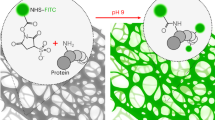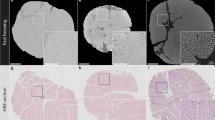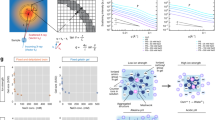Abstract
The extracellular matrix (ECM) is a major regulator of homeostasis and disease, yet the 3D structure of the ECM remains poorly understood because of limitations in ECM visualization. We recently developed an ECM-specialized method termed in situ decellularization of tissues (ISDoT) to isolate native 3D ECM scaffolds from whole organs in which ECM structure and composition are preserved. Here, we present detailed surgical instructions to facilitate decellularization of 33 different mouse tissues and details of validated antibodies that enable the visualization of 35 mouse ECM proteins. Through mapping of these ECM proteins, the structure of the ECM can be determined and tissue structures visualized in detail. In this study, perfusion decellularization is presented for bones, skeletal muscle, tongue, salivary glands, stomach, duodenum, jejunum/ileum, large intestines, mesentery, liver, gallbladder, pancreas, trachea, bronchi, lungs, kidneys, urinary bladder, ovaries, uterine horn, cervix, adrenal gland, heart, arteries, veins, capillaries, lymph nodes, spleen, peripheral nerves, eye, outer ear, mammary glands, skin, and subcutaneous tissue. Decellularization, immunostaining, and imaging take 4–5 d.
This is a preview of subscription content, access via your institution
Access options
Access Nature and 54 other Nature Portfolio journals
Get Nature+, our best-value online-access subscription
$29.99 / 30 days
cancel any time
Subscribe to this journal
Receive 12 print issues and online access
$259.00 per year
only $21.58 per issue
Buy this article
- Purchase on Springer Link
- Instant access to full article PDF
Prices may be subject to local taxes which are calculated during checkout









Similar content being viewed by others
Data availability
All data generated during this study are included in this article (and its Supplementary information files), except for some of the data generated during the revision process. Unpublished data that support the findings of this study are available from the corresponding authors upon request.
References
Jarvelainen, H., Sainio, A., Koulu, M., Wight, T. N. & Penttinen, R. Extracellular matrix molecules: potential targets in pharmacotherapy. Pharmacol. Rev. 61, 198–223 (2009).
Schaefer, L. & Schaefer, R. M. Proteoglycans: from structural compounds to signaling molecules. Cell Tissue Res. 339, 237–246 (2010).
Frantz, C., Stewart, K. M. & Weaver, V. M. The extracellular matrix at a glance. J. Cell Sci. 123, 4195–4200 (2010).
Yurchenco, P. D. Basement membranes: cell scaffoldings and signaling platforms. Cold Spring Harb. Perspect. Biol. 3, a004911 (2011).
Hohenester, E. & Yurchenco, P. D. Laminins in basement membrane assembly. Cell Adh. Migr. 7, 56–63 (2013).
Cox, T. R. & Erler, J. T. Remodeling and homeostasis of the extracellular matrix: implications for fibrotic diseases and cancer. Dis. Model. Mech. 4, 165–178 (2011).
Hynes, R. O. The extracellular matrix: not just pretty fibrils. Science 326, 1216–1219 (2009).
Nelson, C. M. & Bissell, M. J. Of extracellular matrix, scaffolds, and signaling: tissue architecture regulates development, homeostasis, and cancer. Annu. Rev. Cell Dev. Biol. 22, 287–309 (2006).
Iozzo, R. V. & Gubbiotti, M. A. Extracellular matrix: the driving force of mammalian diseases. Matrix Biol. 71-72, 1–9 (2018).
Naba, A. et al. The matrisome: in silico definition and in vivo characterization by proteomics of normal and tumor extracellular matrices. Mol. Cell. Proteom. 11, M111.014647 (2012).
Hynes, R. O. & Naba, A. Overview of the matrisome-an inventory of extracellular matrix constituents and functions. Cold Spring Harb. Perspect. Biol. 4, a004903 (2012).
Naba, A. et al. Characterization of the extracellular matrix of normal and diseased tissues using proteomics. J. Proteome Res. 16, 3083–3091 (2017).
Susaki, E. A. et al. Advanced CUBIC protocols for whole-brain and whole-body clearing and imaging. Nat. Protoc. 10, 1709–1727 (2015).
Tomer, R., Ye, L., Hsueh, B. & Deisseroth, K. Advanced CLARITY for rapid and high-resolution imaging of intact tissues. Nat. Protoc. 9, 1682–1697 (2014).
Erturk, A. et al. Three-dimensional imaging of solvent-cleared organs using 3DISCO. Nat. Protoc. 7, 1983–1995 (2012).
Renier, N. et al. iDISCO: a simple, rapid method to immunolabel large tissue samples for volume imaging. Cell 159, 896–910 (2014).
Pan, C. et al. Shrinkage-mediated imaging of entire organs and organisms using uDISCO. Nat. Methods 13, 859–867 (2016).
Renier, N. et al. Mapping of brain activity by automated volume analysis of immediate early genes. Cell 165, 1789–1802 (2016).
Hama, H. et al. Scale: a chemical approach for fluorescence imaging and reconstruction of transparent mouse brain. Nat. Neurosci. 14, 1481–1488 (2011).
Hama, H. et al. ScaleS: an optical clearing palette for biological imaging. Nat. Neurosci. 18, 1518–1529 (2015).
Chen, L. et al. UbasM: an effective balanced optical clearing method for intact biomedical imaging. Sci. Rep. 7, 12218 (2017).
Chung, K. et al. Structural and molecular interrogation of intact biological systems. Nature 497, 332–337 (2013).
Hou, B. et al. Scalable and DiI-compatible optical clearance of the mammalian brain. Front. Neuroanat. 9, 19 (2015).
Ke, M. T., Fujimoto, S. & Imai, T. SeeDB: a simple and morphology-preserving optical clearing agent for neuronal circuit reconstruction. Nat. Neurosci. 16, 1154–1161 (2013).
Ke, M. T. et al. Super-resolution mapping of neuronal circuitry with an index-optimized clearing agent. Cell Rep. 14, 2718–2732 (2016).
Kuwajima, T. et al. ClearT: a detergent- and solvent-free clearing method for neuronal and non-neuronal tissue. Development 140, 1364–1368 (2013).
Li, W., Germain, R. N. & Gerner, M. Y. Multiplex, quantitative cellular analysis in large tissue volumes with clearing-enhanced 3D microscopy (Ce3D). Proc. Natl. Acad. Sci. USA 114, E7321–E7330 (2017).
Li, W., Germain, R. N. & Gerner, M. Y. High-dimensional cell-level analysis of tissues with Ce3D multiplex volume imaging. Nat. Protoc. 14, 1708–1733 (2019).
Murakami, T. C. et al. A three-dimensional single-cell-resolution whole-brain atlas using CUBIC-X expansion microscopy and tissue clearing. Nat. Neurosci. 21, 625–637 (2018).
Yang, B. et al. Single-cell phenotyping within transparent intact tissue through whole-body clearing. Cell 158, 945–958 (2014).
Mayorca-Guiliani, A. E. et al. ISDoT: in situ decellularization of tissues for high-resolution imaging and proteomic analysis of native extracellular matrix. Nat. Med. 23, 890–898 (2017).
Ott, H. C. et al. Perfusion-decellularized matrix: using nature’s platform to engineer a bioartificial heart. Nat. Med. 14, 213–221 (2008).
Gilpin, A. & Yang, Y. Decellularization strategies for regenerative medicine: from processing techniques to applications. Biomed. Res. Int. 2017, 9831534 (2017).
Levental, K. R. et al. Matrix crosslinking forces tumor progression by enhancing integrin signaling. Cell 139, 891–906 (2009).
Filipe, E. C., Chitty, J. L. & Cox, T. R. Charting the unexplored extracellular matrix in cancer. Int. J. Exp. Pathol. 99, 58–76 (2018).
Guyette, J. P. et al. Perfusion decellularization of whole organs. Nat. Protoc. 9, 1451–1468 (2014).
Hwang, J. et al. Molecular assessment of collagen denaturation in decellularized tissues using a collagen hybridizing peptide. Acta Biomater. 53, 268–278 (2017).
Zhou, J. et al. Impact of heart valve decellularization on 3-D ultrastructure, immunogenicity and thrombogenicity. Biomaterials 31, 2549–2554 (2010).
Gilbert, T. W., Sellaro, T. L. & Badylak, S. F. Decellularization of tissues and organs. Biomaterials 27, 3675–3683 (2006).
Crapo, P. M., Gilbert, T. W. & Badylak, S. F. An overview of tissue and whole organ decellularization processes. Biomaterials 32, 3233–3243 (2011).
Khan, A. A., Vishwakarma, S. K., Bardia, A. & Venkateshwarulu, J. Repopulation of decellularized whole organ scaffold using stem cells: an emerging technology for the development of neo-organ. J. Artif. Organs 17, 291–300 (2014).
Kim, B. S., Kim, H., Gao, G., Jang, J. & Cho, D. W. Decellularized extracellular matrix: a step towards the next generation source for bioink manufacturing. Biofabrication 9, 034104 (2017).
Keane, T. J., Swinehart, I. T. & Badylak, S. F. Methods of tissue decellularization used for preparation of biologic scaffolds and in vivo relevance. Methods 84, 25–34 (2015).
Shafiq, M. A., Gemeinhart, R. A., Yue, B. Y. & Djalilian, A. R. Decellularized human cornea for reconstructing the corneal epithelium and anterior stroma. Tissue Eng. Part C. Methods 18, 340–348 (2012).
Uchimura, E. et al. Novel method of preparing acellular cardiovascular grafts by decellularization with poly(ethylene glycol). J. Biomed. Mater. Res. A 67, 834–837 (2003).
Ota, T. et al. Novel method of decellularization of porcine valves using polyethylene glycol and gamma irradiation. Ann. Thorac. Surg. 83, 1501–1507 (2007).
Kabirian, F. & Mozafari, M. Decellularized ECM-derived bioinks: prospects for the future. Methods https://doi.org/10.1016/j.ymeth.2019.04.019 (2019).
Alhamdani, M. S. et al. Single-step procedure for the isolation of proteins at near-native conditions from mammalian tissue for proteomic analysis on antibody microarrays. J. Proteome Res. 9, 963–971 (2010).
Struecker, B. et al. Improved rat liver decellularization by arterial perfusion under oscillating pressure conditions. J. Tissue Eng. Regen. Med. 11, 531–541 (2017).
Acuna, A., Drakopoulos, M. A., Leng, Y., Goergen, C. J. & Calve, S. Three-dimensional visualization of extracellular matrix networks during murine development. Dev. Biol. 435, 122–129 (2018).
Rios, A. C. et al. Intraclonal plasticity in mammary tumors revealed through large-scale single-cell resolution 3D imaging. Cancer Cell 35, P618–P632.e6 (2019).
Abraham, T. & Hogg, J. Extracellular matrix remodeling of lung alveolar walls in three dimensional space identified using second harmonic generation and multiphoton excitation fluorescence. J. Struct. Biol. 171, 189–196 (2010).
Jungebluth, P. et al. Structural and morphologic evaluation of a novel detergent-enzymatic tissue-engineered tracheal tubular matrix. J. Thorac. Cardiovasc. Surg. 138, 586–593 (2009).
Petersen, T. H. et al. Tissue-engineered lungs for in vivo implantation. Science 329, 538–541 (2010).
Yang, B. et al. Development of a porcine bladder acellular matrix with well-preserved extracellular bioactive factors for tissue engineering. Tissue Eng. Part C. Methods 16, 1201–1211 (2010).
Salabarria, A. C. et al. Local VEGF-A blockade modulates the microenvironment of the corneal graft bed. Am. J. Transplant. 19, 2446–2456 (2019).
Acknowledgements
We thank N. M. Christensen at the Center for Advanced Bioimaging (CAB), University of Copenhagen, for providing microscope access and training; B. Kobbe for purifying collagen XXVIII antibodies; J. Christensen for providing technical advice; and E. Schoof for running the MS/MS profile. We thank P. D. Yurchenco for providing the perlecan-specific antibody. This work was supported by the European Research Council (ERC-2015-CoG-682881-MATRICAN; A.E.M.-G., O.W., M.R., R.R., & J.T.E.), the Danish Cancer Society (R204-A12454; R.R.), German Cancer Aid (Deutsche Krebshilfe; R.R.), a Hallas Møller Stipend from the Novo Nordisk Foundation (J.T.E.), a PhD fellow grant of the Lundbeck Foundation (R286-2018-621; M.R.) the Ragnar Söderberg Foundation Sweden (N91/15; C.D.M.), the Swedish Research Council (2017-03389; C.D.M.), and Cancerfonden Sweden (CAN 2016/783; C.D.M.), the German Research Foundation (DFG) (FOR2722/B2; M.K.), (FOR2722/B1; R.W.), (FOR2722/D2; F.Z.), (FOR2722/M2 and FOR2722/C2; G.S.).
Author information
Authors and Affiliations
Contributions
R.R. and A.E.M.-G. designed the study. A.E.M.-G. developed and established all surgical methods. R.R. collected all antibodies. C.D.M. developed the imaging methods. A.E.M.-G. and M.R. performed the ISDoT. O.W. and R.R. performed the staining. O.W., R.R., M.R., A.E.M.-G., and C.D.M. performed the imaging. T.S., R.W., S.E.H., G.S., M.K., T.I., and F.Z. provided antibodies. F.B. provided wounded cornea samples. O.W., A.E.M.-G., R.R., C.D.M., and J.T.E. wrote the paper. R.R., A.E.M.-G., and J.T.E. supervised the project. All authors discussed the results and commented on the manuscript text.
Corresponding authors
Ethics declarations
Competing interests
The authors declare no competing interests.
Additional information
Peer review information Nature Protocols thanks Benjamin Struecker and other anonymous reviewer(s) for their contribution to the peer review of this work.
Publisher’s note Springer Nature remains neutral with regard to jurisdictional claims in published maps and institutional affiliations.
Related link
Key reference using this protocol
Mayorca-Guiliani, A. E. et al. Nat. Med. 23, 890–898 (2017) https://doi.org/10.1038/nm.4352
Integrated supplementary information
Supplementary Figure 1 LC–MS/MS chromatogram of filtered and unfiltered peptide samples obtained from decellularized tongue tissue washed with 1% Triton X-100.
a. Chromatogram of the unfiltered sample reveals poor detection of peptides and a strong peak with high intensity for Triton X-100 (red frame). The NL value (normalized level of base peak) for Triton X-100 is 1.06E9. b. The chromatogram of the filtered sample shows improved peptide detection. The NL value of Triton X-100 shows a total reduction of intensity by 3 orders of magnitude after filtration (NL: 1.25E6).
Supplementary Figure 2 Overview of the surgical instruments used in the ISDoT protocol.
a. Microvascular clamps. b. Cauterizer. c. Applying forceps for clamps. d. Double-ended microspatula. e. Castroviejo microneedle holder. f. Spring micro-scissors. g. Dumont microforceps with 45° tips. h. Microforceps with ringed tips. i. Periostotome. j. Freer-Yasargil (Spatula). k. Halsey needle holder. l. Mayo scissors. m. Metzenbaum scissors. n. Serrated scissors. o. Tendon scissors. p. Adson forceps with teeth. q. Adson forceps. r. 9-0 Micro-suture. s. 6-0 Suture. t. 26G catheter. u. 24G catheter.
Supplementary Figure 3 Thoracic surgical access.
a. Euthanized mouse pinned on the surgical table. Dotted lines indicate skin incisions. b. Subcutaneous dissection reveals the neck, the thoracic, and abdominal walls. c. Section of the pectoralis muscles (blue arrowheads) and incisions through the eight intercostal spaces (blue arrows). d. Intercostal incisions are united by sectioning the sternum horizontally (dotted line). e. Sternotomy (dotted line 1) and sectioning of the ribs along the thoracic wall (dotted lines 2 and 3). f. Pinning the sectioned thorax reveals the thymus (1), heart (2), lungs (3), and cava vein (4). g. Excision of the thymus reveals the aorta (1), brachiocephalic artery (2), left common carotid artery (3), left subclavian artery (4), internal mammary arteries (5), and brachiocephalic veins (6). h. Elevating the brachiocephalic veins allows clear differentiation of the major arteries (numbering equal to g). (Scale bars, 2 mm unless otherwise stated).
Supplementary Figure 4 Thoracic procedures.
a. Thoracic procedures are based on the selective clamping of major vessels to redirect flow to an area of interest. b. To perfuse the face and neck, a catheter is inserted in the emergence of the aortic arch (1) and micro-sutured (2 and 4) to deliver flow superiorly to the right subclavian artery (3). c. To perfuse the cardio-pulmonary complex it is necessary to clamp the brachiocephalic artery (1), the left common carotid artery (2) and the left subclavian artery (3), leaving the aorta permeable to retrograde perfusion (4). d. To perfuse the territory of the left subclavian artery a clamp is placed immediately after the emergence of the left common carotid artery, leaving the left subclavian artery permeable to retrograde perfusion. e. To deliver perfusion to the cardio-pulmonary complex, insert a catheter into the cava vein at the level of its emergence from the abdominal cavity (1), suture it to avoid back flow (2); the tip must be place at the entrance of the atrium (3). f. The mouse is sectioned (dotted line) above the diaphragm. g. Expose the entrance of the abdominal aorta (1) by elevating the heart and lungs as well as displacing a cava vein catheter (in case of heart decellularization). h. A catheter is inserted into the aorta (1) and sutured (2) to deliver retrograde flow to operations depicted in 2, 3 and 4. (Scale bars, 2 mm).
Supplementary Figure 5 Abdominal access and procedures.
a. Inferior half of mouse showing the abdominal walls and the incisions to access the peritoneal cavity (dotted lines) b. The abdominal aorta catheterized to deliver anterograde flow (1). c. Sectioning and elevating the peritoneum exposes the contents of the peritoneal wall. d. Elevating these contents to the right exposes the catheter (1) and allows incision of the diaphragm (dotted line). This incision is essential to follow the progress of the catheter. Avoid tearing the aorta. The liver (3), stomach (4), spleen (5), pancreas (6), and intestines are on the right, exposing the abdominal arteries and veins to their iliac bifurcation (9). e. To perfuse the celiac trunk (blue arrow), the tip of the catheter must be located superiorly to the emergence of the superior mesenteric artery and the clamp immediately below (blue line). The catheter is sutured to avoid back flow (circle). f. Perfusion of the superior mesenteric artery (blue arrow) requires suturing the catheter below the celiac trunk (circle) and clamping the aorta immediately below (blue line). g. Perfusing the kidneys requires suturing the catheter inferiorly to the superior mesenteric artery and clamping below the left renal artery (blue line). h. To perfuse the common iliac arteries the catheter is pushed until the tip is located at the aortic bifurcation (blue arrows) and sutured (circle) to avoid back flow. (Scale bars, 2 mm unless otherwise stated).
Supplementary Figure 6 Liver catheterization.
a. Elevating the liver and the intestines reveals the portal vein (1). b. The catheter is inserted as inferiorly as possible to ensure liver perfusion (arrow) and sutured to avoid back flow (circles). (Scale bars, 2 mm).
Supplementary Figure 7 Decellularized ECM immunostaining with a single primary antibody and a 488-nm emission secondary antibody.
All antibodies shown are alternatives to the ones used against the same antigen shown in Figs. 6 and 7. These antibodies have been produced in guinea-pig (anti-periostin, RRID:AB_2801620; anti-TGFBI, RRID:AB_2801623; anti-collagen XIV, RRID:AB_2801626; anti-collagen XXVIII, RRID:AB_2801634). (Scale bars, 100 µm). All experiments were carried out under the authorization and guidance of the Danish Inspectorate for Animal Experimentation.
Supplementary information
Supplementary Information
Supplementary Figs. 1–7
Supplementary Video 1
Movie of a 3D reconstruction of a z-stack from decellularized tissue adjacent to the aorta stained for laminin-γ1 (rat anti-laminin-γ1, 555 nm, cyano) and collagen IV (goat anti-collagen IV, 647 nm, magenta). All experiments were carried out under the authorization and guidance of the Danish Inspectorate for Animal Experimentation.
Rights and permissions
About this article
Cite this article
Mayorca-Guiliani, A.E., Willacy, O., Madsen, C.D. et al. Decellularization and antibody staining of mouse tissues to map native extracellular matrix structures in 3D. Nat Protoc 14, 3395–3425 (2019). https://doi.org/10.1038/s41596-019-0225-8
Received:
Accepted:
Published:
Issue Date:
DOI: https://doi.org/10.1038/s41596-019-0225-8
This article is cited by
-
Immunogenicity of decellularized extracellular matrix scaffolds: a bottleneck in tissue engineering and regenerative medicine
Biomaterials Research (2023)
-
Biofabrication, biochemical profiling, and in vitro applications of salivary gland decellularized matrices via magnetic bioassembly platforms
Cell and Tissue Research (2023)
-
Organ-specific extracellular matrix directs trans-differentiation of mesenchymal stem cells and formation of salivary gland-like organoids in vivo
Stem Cell Research & Therapy (2022)
-
Extracellular matrix dynamics: tracking in biological systems and their implications
Journal of Biological Engineering (2022)
-
Collagen-based materials in reproductive medicine and engineered reproductive tissues
Journal of Leather Science and Engineering (2022)
Comments
By submitting a comment you agree to abide by our Terms and Community Guidelines. If you find something abusive or that does not comply with our terms or guidelines please flag it as inappropriate.



